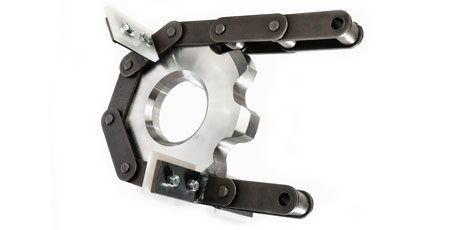March 18, 2015, in Care Tips
Better Chain Life: Where does it begin?
As we look over various applications we see many ways that chain life could be improved, and the operation perform better if only there wasn't the many restrictions designed into the unit. If the system designer would take into consideration the day to day operating and maintenance requirements, chain life could be increased many times over just by following a few good principles. Where does it begin? Right at the conception stage, before the first pencil is laid on the drawing paper. A discussion with the maintenance people is quite a step in the right direction, the consideration of several other thoughts. Remember, our goal is to design a system that will not only do the job required, but one that will also operate efficiently, at low cost, with little down time and ease of maintenance and replacement when necessary. Although there are many ideas that need to be thought of, a few come to mind that should be considered:
- Leave ample room, including headroom, so maintenance people can do their job efficiently and without unnecessary hazards.
- Select chain wisely. It is better to over specify a chain than to undersize the chain. Remember to use a chain with the largest diameter pin in that series to take advantage of the benefits of larger diameter pins in overall job performance.
- Stay away from drives that cause excess flexing of the chain. Every time a chain flexes, there is increased wear at the joints. "S" drives, for example, are very hard on chain and actually decrease the life of the chain.
Other drive designs that reduce chain life are "water fall", often used with drag chains, or any application that causes the chain to run over many sprockets. The fewer flexes that the chain performs in its normal operation, the better. - Leave room for a proper catenary or chain sag. A proper sag is necessary for good chain life. Excess tightening of the take-up places the joints under stress, causes poor sprocket/chain interaction and if carried to an extreme, can actually bind up the system. Remember, a sag is essential.
- Leave room for sprockets. As a general rule, for good operation, the more teeth in the sprocket, the better the operation. We try to have an odd number of teeth with the ideal sprocket diameter of 3-4 times the pitch of the chain. Thus a 6" pitch chain would have a sprocket of about 24" in diameter.
- Use a UHMW wear plate where possible to reduce friction and excessive wear on the chain as it slides over a surface. If metal to metal contact is necessary, try to balance the wear plate material with the hardness of the chain sidebar.
- Use split sprockets in hard to reach and hard to replace areas. Sprockets should be replaced whenever new chain is required. By using split sprockets the task of removing shafts and other obstacles is eliminated making the overall task much simpler and more cost efficient.

